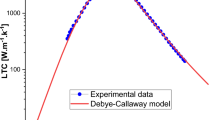Abstract
King [1] established that due to the discrete nature of their dislocation structure, finite length grain boundaries (GBs) in polycrystalline materials possess discrete values of misorientation angle. For a GB with a length that is not a multiple of the GB period, this leads to the formation of specific disclinations at their junctions with neighboring GBs, which compensate the difference between the misorientations of finite and infinite boundaries. In the present paper the origin of these compensating disclinations within GB triple junctions is elucidated and their strength is calculated using the disclination-structural unit model. It is shown that for a GB with length of about 10 nm the junction disclinations can have a strength value not more than 1°, in contrast to King's calculations that indicate much larger values. Elastic energies of triple junctions due to compensating disclinations are calculated for both equilibrium and non-equilibrium structures of a finite length GB, which differ by the position of the grain boundary dislocation network with respect to the junctions. The calculations show that triple junction energies are comparable to dislocation energies, and that compensating disclinations can play a significant role in the properties of nanocrystalline metals with grain sizes less than about 10 nm.
Similar content being viewed by others
References
A.H. King, Mater. Sci. Forum. 126–128, 221 (1993).
A.P. Sutton and V. Vitek, Philos. Trans. Roy. Soc. (London) A309, 1 (1983).
W.T. Read and W. Shockley, Phys. Rev. 78, 275 (1950).
G.-J. Wang and V. Vitek, Acta Metall. 34, 951 (1986).
K.K. Shih and J.C.M. Li, Surf. Sci. 50, 109 (1975).
V.Yu. Gertsman, A.A. Nazarov, A.E. Romanov, R.Z. Valiev, and V.I. Vladimorov, Philos. Mag. A59, 1113 (1989).
A.A. Nazarov, O.A. Shenderova, and D.W. Brenner, Mater. Sci. Eng. A281, 148 (2000).
A.P. Sutton, Acta Metall. Mater. 36, 1291 (1988).
K.N. Mikaelyan, I.A. Ovid'ko, and A.E. Romanov, Mater. Sci. Eng. A259, 132 (1999).
K.N. Mikaelyan, I.A. Ovid'ko, and A.E. Romanov, Phys. Metal Metallogr. 90(3), 224 (2000).
A.H. King, Interface Sci. 7, 251 (1999).
A.A. Nazarov and A.E. Romanov, Philos. Mag. Lett. 60, 187 (1989).
P. Müllner and W.-M. Kuschke, Scripta Materialia 36, 1451 (1997).
G.P. Dimitrakopulos, Th. Karakostas, and R.C. Pond, Interface Sci. 4, 129 (1996).
G.P. Dimitrakopulos, Ph. Komninou, Th. Karakostas, and R.C. Pond, Interface Sci. 7, 217 (1999).
V.I. Vladimirov, V.Y. Gertsman, A.A. Nazarov, and A.E. Romanov, Preprint No. 1150 (Leningrad, A.F. Ioffe Physico-Technical Institute, 1987).
J.P. Hirth and J. Lothe, Theory of Dislocations (John Wiley and Sons, New York, 1982).
A. Caro and H. Van Swygenhoven, Phys. Rev. B63, 134101 (2001).
S.G. Srinivasan, J.W. Cahn, H. Jonsson, and G. Kalonji, Acta Mater. 47, 2821 (1999).
A.A. Nazarov, A.E. Romanov, and R.Z. Valiev, Scripta Mater.34, 729 (1996).
K. Reimann and R. W¨urschum, J. Appl. Phys. 81, 7186 (1997).
Author information
Authors and Affiliations
Rights and permissions
About this article
Cite this article
Nazarov, A.A., Bachurin, D.V., Shenderova, O.A. et al. On the Origin and Energy of Triple Junction Defects Due to the Finite Length of Grain Boundaries. Interface Science 11, 417–424 (2003). https://doi.org/10.1023/A:1026143927269
Published:
Issue Date:
DOI: https://doi.org/10.1023/A:1026143927269




